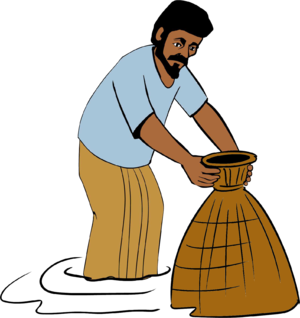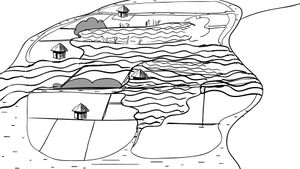Views
Actions
Main Page
Welcome to Blue Gold Program wiki![edit | edit source]
Things are being set up at the moment. While these are being prepared, you can learn more about the Blue Gold Program here.
Table of Contents[edit | edit source]
Glossary
Acronyms
Key Stakeholders
EXECUTIVE SUMMARY – “WATER MANAGEMENT FOR DEVELOPMENT”
A BACKGROUND AND CONTEXT
SUMMARY – BACKGROUND AND CONTEXT
1 Introduction
1.1 Project “headlines” - scope: objectives and goals, geographical area (map), elements, amount of investment, etc
1.2 Purpose of report – to complement PCRs by BWDB, DAE; record lessons learnt for design of future interventions in coastal zone
1.3 Water management for development – importance of PWM in future investment strategies for the coastal zone under the umbrella of the Bangladesh Delta Plan
1.4 Structure of report
2 Institutional Setting
2.1 Donors/sponsors
2.1.1 EKN
2.1.2 GoB – MoWR, MoA
2.2 Executing organisations and management arrangements
2.2.1 BWDB – catchment-based, not co-located with local government at UP/UZP level
2.2.2 DAE
2.2.3 DLS/DoF
2.3 Local Government Institutions
2.3.1 Union Parishads
2.3.2 Other relevant public sector organisations (BADC, LGED)
2.4 Private Sector – private companies and goods and service providers
3 Social, Physical and Environmental Context
3.1 Geography of the coastal zone – tidal rivers, sedimentation, erosion
3.2 History of polders – development of agriculture, 1960s/1970s empolderisation, expansion of shrimp/prawn production
3.3 Social – population segmentation, hard core poor
3.4 Status of polder physical infrastructure – age, project investments, impact of erosion
3.5 Environmental – water flows, water quality (salinity), sedimentation
4 Timeline of Key Events
5 Project Design
5.1 Policy environment
5.1.1 National Water Policy 1999
5.1.2 BWDB Act 2000
5.1.3 Guidelines on Participatory Water Management 2001
5.1.4 Bangladesh Water Act 2013
5.1.5 Participatory Water Management Rules 2014
5.1.6 Water Rules 2018
5.1.7 Bangladesh Delta Plan 2018
5.2 Previous history
5.2.1 EIP (1975-1997)
5.2.2 IPSWAM (2003-2011)
5.2.3 WMIP (2008-2015)
5.2.4 SWIWARPMP (2007 to date?)
5.3 Project definition – how differs from predecessors eg inclusion of DAE and DLS/DoF, BGIF
5.3.1 EKN – Program Document
5.3.2 BWDB - logframe, DPP and RDPP
5.3.3 DAE - logframe, DPP and RDPP
5.3.4 Theory of change (February 2017?)
5.3.4.1. Helix, interlinked PWM activities, integration and functionality
5.3.4.2. Reinforcing Inclusiveness
5.4 Investments by EKN, GoB
5.5 Polder selection – lessons learnt (peri-urban, …)
5.6 Environmental impact assessments
B BGP Interventions: WATER INFRASTRUCTURE
SUMMARY – WATER INFRASTRUCTURE
6 Introduction – linkages infra – PWM – production shift
7 Overall targets/objectives of infrastructure investment
7.1 History of infrastructure in 22 polders – type, nature
7.2 Achievements against overarching objectives
8 Blue Gold investments
8.1 DPP and RDPP
8.1.1 History (noting that participatory planning is not allowed for in planning commission straitjacket)
8.1.2 Missing budget heads from original DPP – land acquisition, new structures, insufficient allocation for emergencies - and implications
8.1.3 Crash program (?)
8.1.4 Lessons learnt
8.2 Costs of infrastructure investments
9 Preparatory Works
9.1 Survey and Design Data Collection
9.2 Design
9.3 Estimations
10 Construction
10.1 Contracting modalities
10.1.1 Contractors
10.1.2 Labour Contracting Societies
10.1.3 BWDB Mechanical Engineering
10.2 Terminated contracts
10.3 Construction quality
10.3.1 Context – tidal conditions, salinity, land availability (eg for retired embankments, borrow pits)
10.3.2 Nature of contractors – availability of equipment
10.4 Maps and statistics (in annex)
11 Reimbursement process
C BGP Interventions: PARTICIPATORY WATER MANAGEMENT
SUMMARY – PARTICIPATORY WATER MANAGEMENT
12 Introduction – linkages infra-PWM-production shift
13 Water management organisations
13.1 History – WMGs initially established under Dept of Cooperatives, from 2014 transferred to BWDB in accordance with PWMR 2014 - explain differences between DoC and PWMR, implications (repeat of formation and registration causing set-back)
13.2 Unified/integrated approach to PWM (Field Manual, May 2017)
13.3 Focus on functionality
13.3.1 Core function – water resource management
13.3.2 Role of WMO supporting local economic development
13.4 WMGs and WMAs – data plus discussion on criteria for boundaries (community or catchment) and size (one or more WMAs per polder)
13.5 Role of LGIs - partnerships
13.6 Support organisations – OCWM and constraints
14 WMO capacity building (refer to related but separate sections on FFS/MFS, women’s economic empowerment)
14.1 From training to evolving & adaptive
14.2 WMGs – collective actions and networking
14.3 WMAs
14.4 O&M Sub-committees (maybe include under WMA’s)
14.5 Women Economic Empowerment
14.6 Participatory monitoring
15 Operation and Maintenance
15.1 Operating infrastructure (sluice, and small scale)
15.2 Maintaining infrastructure
15.2.1 O&M Agreements
15.2.2 Major and Emergency repairs – including case study of P29
16 In-Polder Water Management
16.1 Institutional capacity – little technical knowledge/experience in DAE/BWDB, no joined-up thinking between WMG and sluice
16.2 Evolution – WMGs-> sluice catchments -> role of WMA..
16.3 CAWM – SSWMI
16.4 Horizontal learning – exchange visits
16.5 Catchment planning
17 Consolidating PWM interventions
17.1 National Conference
18 Maps – spatial representation of interventions (Annex)
D BGP Interventions: PRODUCTION SHIFT
SUMMARY – PRODUCTION SHIFT
19 Introduction – linkages infra-PWM-production shift/ twin livelihood improvement strategies
20 Commercialising Farmers
20.1 Original approach
20.2 Farmer Field Schools
20.2.1 Technology transfer (+ linked to wrm)
20.2.2 Market Orientation/FAAB/farmer decision making
20.3 Demonstrations (DAE demo, CII, private sector…)
20.4 Horizontal Learning
20.5 Farmer Organisation
20.6 Market Systems Development
20.6.1 other actors (including WMO)
20.6.2 Local Resource Network (link with role of WMO chapter C)
20.6.3 Agricultural Innovation System
20.7 Capacity building
E BGP Interventions: REINFORCING INCLUSIVENESS
SUMMARY – REINFORCING INCLUSIVENESS
21 Introduction
22 Women empowerment
22.1 GLD capacity development
22.2 Feminisation of agriculture
22.3 BWDB Gender Action Plan
23 Poverty focus – outcome of elements specifically targeting the poor (ie FFSs, labour opportunities, LCSs etc)
23.1 FFS – Food Security
23.1.1 Original Approach
23.1.2 Refocused FFS
23.1.3 DAE, DLS, DoF
23.1.3.1. Involvement
23.1.3.2. Access to animal health
23.1.4 Capacity building
23.2 LCSs
23.2.1 Development objectives
23.2.2 Scope of construction work
23.2.3 Guidance note - focus on selection of LCS members
23.2.4 Outcome from LCS study
F DEVELOPMENT OUTCOMES
SUMMARY – DEVELOPMENT OUTCOMES
24 Overview M&E
24.1 PM results
24.2 Tracker results
25 Outcomes
25.1 Agricultural production changes
25.2 Homestead FFS
25.3 Fisheries – CFWM/CLF
25.4 Socio Economic
G PROJECT MANAGEMENT
SUMMARY PROJECT MANAGEMENT
26 Project Management Arrangements
26.1 Implementing modalities
26.2 PSCs/PMCs
26.3 MoWR/MoA collaboration not served by separate RDPPs and PMCs, no single PSC
26.4 Review Missions - 2014, 2015, 2016, 2017, 2018 (refinement of project scope - removal of vocational training, reduction in BGIF budget and allocation to WMKIP)
26.5 EKN/BWDB/DAE/TA Coordination Meetings
26.6 Progress reporting - BWDB, DAE, TA
26.7 Annual Work Plans
26.8 Polder Development Plans
27 Technical Assistance
27.1 Team
27.1.1 Organisational structure
27.1.2 Internal management
27.2 TA Services
27.2.1 Operations
27.2.2 TA contracted services – studies etc
27.2.3 DoF/DLS FFS
28 Organisational development
28.1 (re)-drafting ToC
28.2 Decentralisation
28.3 Exit strategy
29 Training (approach shift and internal – capacity building covered in both PWM/Production legs)
29.1 Large-scale training
29.2 Customised training
30 Horizontal Learning (as approach – HL to be covered in both PWM/Production legs)
30.1 Methodology and approach
30.2 Evaluation by Access Agriculture
30.3 Evolution of strategy
31 Communications
31.1 Communications
31.1.1 Barta
31.1.2 Drama
31.1.3 Factsheets
31.1.4 Videos
31.1.5
32 Monitoring and evaluation
32.1 Data sources
32.1.1 Baseline and end-line household surveys
32.1.2 WMG outcome surveys 2018, 2019 and 2020
32.1.3 Specific impact surveys
32.1.4 DAE data
32.1.5 Satelligence
32.1.6 WMG tracker (see also Section 27.1)
32.2 Polder dashboard and health checks
32.2.1 Project modalities
32.2.2 Post-project data management
32.3 Trend watcher
33 Project database
33.1 WMG tracker
33.2 Trend Watcher
34 Environmental Impact Assessments
34.1 Overview and issues
34.2 Modalities
34.2.1 CEGIS
34.2.2 BWDB
H INNOVATION FUND
SUMMARY – INNOVATION FUND
35 Objectives
35.1 little guidance given in Project Document, supplemented during ARM 2016?, partial reallocation of budget to WMKIP
35.2 Water management
35.3 Productive sectors
36 BGIF Procedure Manual
37 Range of projects and implementing agencies
38 Contracting modalities
39 Lessons learnt
40 Achievements

